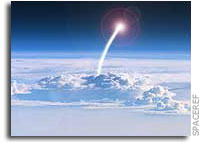NASA, FAA Advance National Goals in Commercial Human Space Transportation with Landmark Agreement

The Federal Aviation Administration (FAA) and NASA have signed a historic agreement to coordinate standards for commercial space travel of government and non-government astronauts to and from low-Earth orbit and the International Space Station (ISS).
The two agencies will collaborate to expand efforts that provide a stable framework for the U.S. space industry, avoid conflicting requirements and multiple sets of standards, and advance both public and crew safety.
The Memorandum of Understanding (MOU) signed by the two agencies establishes policy for operational missions to the space station. Commercial providers will be required to obtain a license from the FAA for public safety. Crew safety and mission assurance will be NASA’s responsibility. This approach allows both agencies to incorporate experience and lessons learned as progress is made.
“This important agreement between the FAA and NASA will advance our shared goals in commercial space travel,” said U.S. Transportation Secretary Ray LaHood. “Working together, we will assure clear, consistent standards for the industry.”
“This agreement is the next step in bringing the business of launching Americans back to American soil,” Charles Bolden, NASA administrator said. “We are fostering private sector innovation while maintaining high standards of safety and reliability to re-establish U.S.-crewed access to low-Earth orbit, in-sourcing work to American companies and encouraging the development of dynamic and cost-effective spaceflight capabilities built to last.”
“The Obama administration recognizes the scientific, technological and economic benefits of maintaining the United States’ leadership in space travel and exploration,” said FAA Acting Administrator Michael Huerta. “This agreement between the FAA and NASA continues and advances those vital national interests.”
NASA’s Commercial Crew Program aims to facilitate development of a U.S. commercial crew space transportation capability with the goal of achieving safe, reliable and cost-effective access to and from low-Earth orbit and the International Space Station. The policy established in the MOU clarifies for potential commercial providers the regulatory environment for operational missions to the orbiting laboratory. It also ensures that the two agencies will have compatible processes for ensuring public safety.
The FAA is responsible for regulating and licensing all U.S. private companies and individuals involved in commercial space transportation. To date, the FAA Office of Commercial Space Transportation has licensed 207 successful launches, including two non-orbital commercial human space flights in 2004 and the recent first launch to the ISS and re-entry of a non-manned commercial spacecraft. For details on FAA commercial space transportation responsibilities, visit:
http://www.faa.gov/news/fact_sheets/news_story.cfm?newsId=12179
In addition, the agreement addresses proper protocols for implementation, financial obligations, liability, free exchange of data and information, and other administrative obligations between the FAA and NASA. To view the agreement, click on: http://go.nasa.gov/Lru8iQ
For more information on NASA’s Commercial Crew Program, visit: http://www.nasa.gov/commercialcrew
For more information on the FAA’s Office of Commercial Space Transportation, visit: http://www.faa.gov/about/office_org/headquarters_offices/ast








